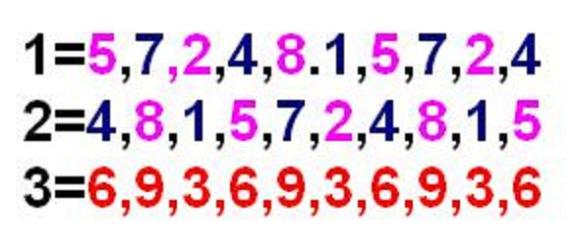The 1-4-7, the 2-5-8 and the 3-6-9 numbers.
The Bible,Numbers 7:12-89 and the Solfege Scale.
Dr Joseph Puleo discovered a pattern of six repeating codes he claimed he had uncovered within the bible. These he believed were encoded,appropriately enough,into
the Book of Numbers, chapter 7,in verses 12 through 83.
When he deciphered these verses reducing the verse numbers to their single digit integers,
the code revealed a series of six electromagnetic sound frequencies
that he believed had correspondence with the six missing tones of the ancient Solfeggio scale.
The six number sequences he had arrived at were as follows:
396, 417, 528, 639,741 and 852.
1. Ut = 396 = 9
2. Re = 417 = 3
3. Mi = 528 = 6
4. Fa = 639 = 9
5. Sol = 741 = 3
6. La = 852 = 6
Looking through this chapter, we first notice that it renders 12 separate lists, each one appearing to be generally similar to the others. Each list begins with “on the first day, on the second day” etc… then provides a list of what had been sacrificed.
By writing down the corresponding verse number each time it says “on the first/second etc day”
Then if we convert each of those verse numbers to single digits.
It renders the following pattern: 396396396 etc
We could go ahead and dismiss this as being coincidence,however he then adds that
if we write down the corresponding verse number every time it says
“And his offering was one silver charger”
and reduce those values to single digits.
This will render the pattern 417417417417 etc
And if we follow the same principle with the next one, “One spoon of ten shekels of gold”
This contributes the pattern 528528528528 etc
This system,Puleo claims will work with every single verse in Numbers 7:12-89
These concealed number sequences Puleo discovered happen to mesh very precisely with the numerics rendered by our device formed by the 24 Fibonacci numbers.
Could it be we are getting a first glimpse of something which might be construed as a possible ‘theory of everything’?
Discovering the identical numeric sequence within the PRIME NUMBERS certainly encouraged us regarding the possibility of this belief.
The prime numbers also just happen to display this same natural three part division.
Therefore
the indivisible numbers
1, 2, 3
are representative of the primary terms of 3 different numeric sequences:
1 —> 5, 7, 11, 13, 17, 19, 23, 25, 29, 31 … (divisible by 1)
2 —> 4, 8, 10, 14, 16, 20, 22, 26, 28, 32 … (divisible by 2)
3 —> 6, 9, 12, 15, 18, 21, 24, 27, 30, 33 … (divisible by 3)
Lets take this further;
Base 9 vortex math analysis of the above sequences;
Note the interweaving pattern of oscillation of the 1-4-7 and the 2-5-8 sequences
whereas the 3-6-9 patterning remains the constant vector.
The numbers in the two columns (1 and 2) added together
Vertically,
renders the following sequence;
9,6,3,9,6,3,9,6,3,9.
(By base 9 reduction)
(This is visibly mirroring a prominent feature incorporated within Raphael’s painting of ‘The School Of Athens’-the border motif on the ceiling arch is 24 fold, echoing our 24 reduced Fibonacci numbers,is divided into two blocks of 12,each is represented by one of 24 ‘greek keys’ (Meandros) following the exact same modelling as the red and black 124875 sequences we have noted in the image above.




